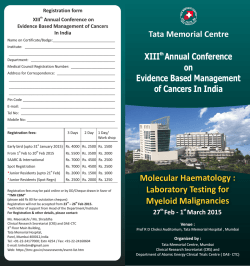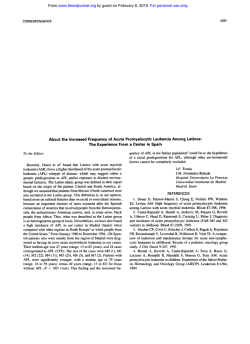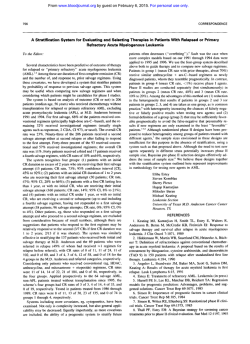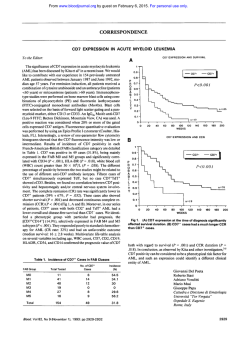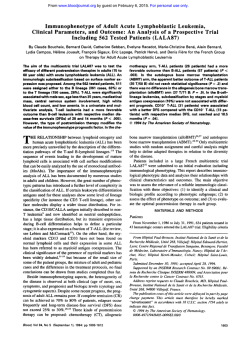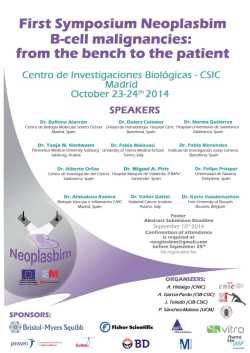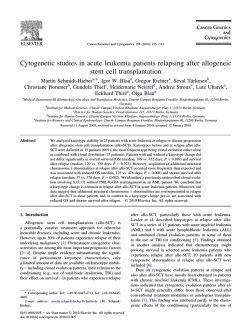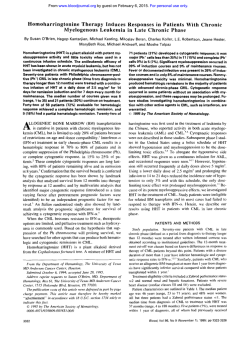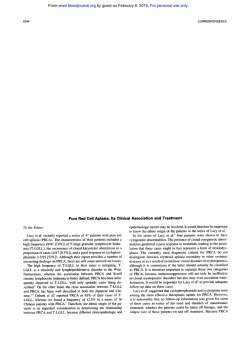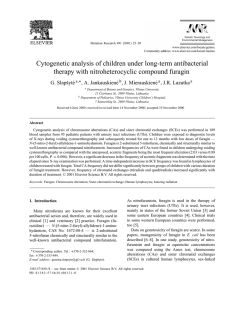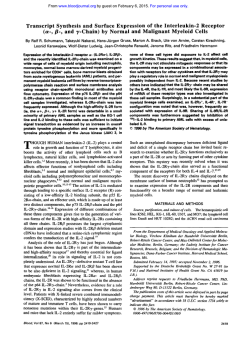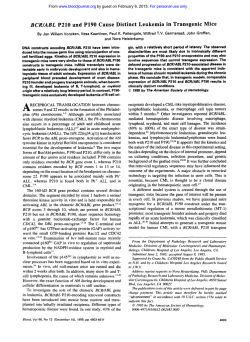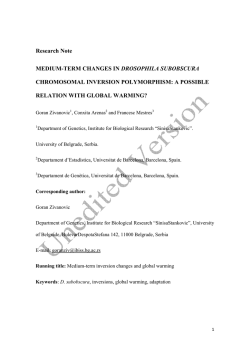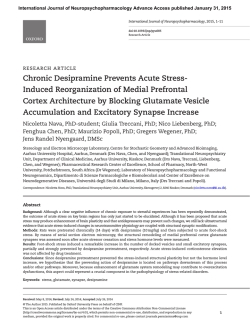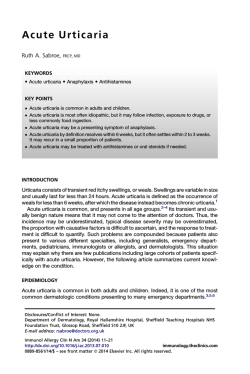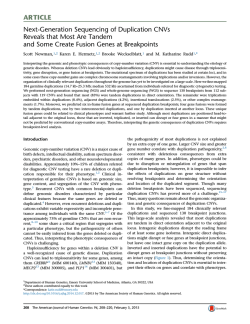
Cytogenetic Profile of Minimally Differentiated (FAB MO
Cytogenetic Profile of Minimally Differentiated (FAB MO) Acute Myeloid Leukemia: Correlation with Clinicobiologic Findings By Antonio Cuneo, Augustin Ferrant, Jean Louis Michaux, Marc Boogaerts, Hilde Demuynck, Angeline Van Orshoven, Arnold Criel, Michel Stul, Paola Dal Cin, J e s u s Hernandez, Bernard Chatelain, Chantal Doyen, Andries Louwagie, Gianluigi Castoldi, Jean-Jacques Cassiman, and Herman Van Den Berghe Cytogenetic data were studied in 26 patients with de novo acute myeloid leukemia (AML) with minimal myeloid differentiation, corresponding to the MO subtype of the FrenchAmerican-British classification, in correlation with cytoimmunologic and clinical findings. Clonal abnormalities were detected in 21 cases (80.7%). 12 of which had a complex karyotype.Partial or total monosomy 5q and/or7q was found, either as the sole aberration or in all abnormal metaphases, in 11 patients; in 8 cases, additional chromosome changes were present, including rearrangements involving 12~12-13 and2p12-15 seen in 3 cases each. Five patients had trisomy 13 as a possible primary chromosome change; in 5 cases, nonrecurrent chromsome abnormalitieswere obwith chromosome served. Comparison ofthesefindings data from 42 patients with AML-M1 shows that abnormal karyotypes, complex karyotypes, unbalanced chromosome changes (-5/5q- and/or -7/7q- and +l31 were observed much morefrequently in AML-MO than inAML-M1. Patients with abnormalities of chromosome 5 and/or 7 frequently showed trilineage myelodysplasia and low white bloodcell count. Despite their relatively young age, complete remission was achieved in 4 of 11patients only. Patients with 13 were elderly males with frequent professional exposure t o myelotoxic agents. Unlike patients with clonal abnormalities, most AML-MO patients with normalkaryotype showed 1% t o 2% peroxidase-positive blast cells at lightmicroscopy and frequently achieved CR. It is concluded that (1)AML-MO shows a distinct cytogenetic profile, partially recalling that of therapy-related AML, (2) different cytogenetic groups of AML-MO can be idenitified showingcharacteristic clinicobiologic features, and (3)chromosome rearrangements may partially account for theunfavorable outcome frequently observed in these patients. 0 1995 by The American Society of Hematology. M or CD13 myeloid antigens or ultrastructural MPO) as well as negativecriteria(ie,negativity for lymphoid antigens) were put forward to avoid confusing this leukemia with leukemia with stem cell phenotype,' with lymphoblastic leukemias, and with biphenotypic leukemias.' Little is known about the clinical and biologic significance of thisnewlyidentifiedsubset of AML; however,a low complete remission (CR) rate has recentlybeendescribed in 15 patientsclassifiedaccording to the FAB proposals, suggesting that a poor prognosis may be associated with this leukemia, possibly because of the convergence of unfavorable cytogenetic and immunologic features.' In view of the well-established importance of cytogenetic findings in acuteleukemias,' we analyzedthe cytogenetic profile in 26 cases of de novo AML-MO, in correlation with cytologic, immunologic, and clinical features. INIMALLY DIFFERENTIATED acute myeloid leukemia(AML)was recognizedasadistinctentity asearly as 1987 by Leeetal,'whodescribedcytologic, immunologic, and clinical features in 10 patients with morphologically undifferentiated leukemia by light microscopy and positivity for theultrastructural myeloperoxidase (MPO) as well as for myeloid antigens. Later on, a number of studies confirmed that a significant fraction of leukemias otherwise classified as "undifferentiated" can be shown to be myeloid in nature, when applying sensitive immunologic and electron microscopy techniques?4 However, because diagnostic criteria in these series were not uniform, the French-American-British (FAB) Cooperative group recently proposed guidelines for the recognition of this form of leukemia, now referred to as AML-MO.' The 3% upper cutoff for M P 0 positivity was setfor its distinction from AML-M 1, and positive (ie, expression of CD33 and/ + PATIENTS AND METHODS From the Institute of Haemutolog>), University of Ferram, Ferrara,Italy; the Department of Haematology,CliniquesUniversitaires St-Luc, Brussels; the Departments of Haematology and ClinicalBiologyand the Center for Human Genetics,University of Leuven,Leuven; the Department of Haematology, A.Z. St. Jan, Brugge; and the Department of Haematology, Cliniques Univer.sitaires de Mont-Godinne, Mont Godinne, Belgium. Submitted December 7, 1994; accepted Februaty 2, 1995. Supported in part by MURST fondi (40%)and by Fondi regionali (60%). This text presents research results of the Belgian programme on InteruniversityPoles of attractioninitiatedby the BelgianState, Prime Minister's Ofice, Science Policy Programming.The scient@ responsibility is assumed by its authors. Address reprint requests to H. Van Den Berghe, Centerfor Human Genetics, Herestraat 49, B-3000 Leuven, Belgium. The publication costs of this article were defrayedin part by page chargepayment.Thisarticle must thereforebeherebymarked "advertisement" in accordance with 18 U.S.C. section 1734 solely to indicate this fact. 0 1995 by The American Socier?, of Hemato1og.y. 0006-4971/95/ss12-0035~3.00/0 3688 Patient population. Major criteria for the diagnosis of AML-MO adopted in this study are the following: ( I ) less than 3% blast cells stained by light microsopy M P 0 andsudan black-B (SBB); (2) reactivity with CD33 andor CD13 myeloid antigens; and (3) negativity for lymphoid antigens (the isolated expression of CD7 or terminal deoxynucleotydil transferase (TdT) did not preclude the diagnosis of AML-MO). Two patients without expression of myeloid and lymphoid antigens were classified as AML-MO basedonthe presence of 1% to 2% positive blast cells with M P 0 and SBB.'' Forty-one patients with a presumptive diagnosis of de novo AMLMO were selected among approximately 700 newly diagnosed AMLs, seen at the University Institutes of Hematology in Brussels, Leuven, Mont-Godinne, Brugge, and in Ferrara since 1984. Fifteen patients were excluded from this analysis for the following reasons: ( I ) a diagnosis ofAML-M1, of AML-MS,and of biphenotypic leukemia was thought to be more appropriate at review of cytology and immunophenotype (7, I , and 2 cases, respectively); and (2) karyotype not available ( 5 cases). To compare cytogenetic findings in this cohort of patients and in a cytologically similar subset of AML, 42 patients with an AMLM1 FAB diagnosis, seen at our institutions during the study period, were selected for karyotype review. Differences in the distribution Blood, Vol 85,No 12 (June 15). 1995:pp 3688-3694 CYTOGENETICS OF AML-MO of clonal abnormalities among different groups were compared using the x' test. Morphologic studies. Review of bone marrow (BM) and peripheral blood smears stained by May-Grunwald-Giemsa and by cytochemical reactions including MPO, SBB, and alpha-naphthyl acetate esterase with and without fluoride inhibition, periodic-acid Schiff (PAS), and acid phosphatase (AcP)" was performed, and the patients were classified according to the FAB riter ria.^." Attention was devoted to the presence of dysplastic features of BM cells.13 When all three lineages were affected, AML with trilineage myelodysplasia (MDS) was diagnosed as previously reported.I4 Immunologic studies. Cytofluorimetric analysis of the phenotype ofBM and/or peripheral blood cells was performed as previously de~cribed,'~ gating primarily on the blast cell population. To minimize nonspecific Fc-receptor binding, all samples were preincubated with2.5% human AB serum. Nonspecific isotypic mousemonoclonal antibodies (MoAbs) served as negative control for the primary agent. The expression of following antigens was tested using commercially available reagents (Ortho Diagnostics, Raritan, NJ;Becton Dickinson, Mountain View, CA) (1) myeloid, erythroid, and platelet antigens: CD33, CD13, CD15, CDllb, CD14, glycophorine, CD41, and/or CD61; and (2) lymphoid antigens: CD7, CD2, CD3, CD5, CD22, CDlO, and CD19. The expression of the CD34 stem cell marker was also tested; reactivity for the 17F11 MoAb, recognizing an epitope of the c-kit protein product (CD1 17)," was assayed since 1993. A polyclonal antiserum was used for TdT assay (Gibco BRL, Gaithersburg, MD). A sample was considered positive when 20% ofblast cells showed fluorescence above control. However, in accordwith previous report~,"~ the ' ~ 10% cutoff was thought to be more appropriate for the MoAb detecting the c-kit protein product. Cytogenetic and molecular genetic studies. Cytogenetic analysis was performed at diagnosis in all patients by a synchronization technique with methotrexate and bromodeoxyuridine or thymidine. Metaphases were either R-banded or G-banded. Chromosome aberrations were described according to the International System for Human Cytogenetic Nornenclat~re.'~ Complex karyotypes were defined by the presence of three or more events of translocation and nondisjunction in the same clonez0or by the presence of multiple unrelated clones. The configuration oftheIgand T-cell receptor (TCR) genes were analyzed at diagnosis in 15 patients for whom representative frozen samples were available. Methods have been detailed elsewhere." After DNA extraction by standard techniques, digestion with Bgl 11, BamHI, EcoRI, HindIII, and Kpn I, respectively, was performed. DNA fragments were size-fractionated on 0.7% agarose gels and blotted onto Hybond N+ filters. Hybridization to probes "P-labeled by primer extension was performed. Ig gene rearrangement was assayed using a heavy chain joining (JH) region probe (a 3.8-kb BamHI-Hind111 fragment) and two constant region probes, CK and CA (2.7- and 0.8-kb EcoRI fragments; from Dr R. Dalla Favera, New York University Medical Center, New York, NY). TCR genes were analyzed for the 6,y , and p chains, respectively. The TCR-6 rearrangement was studied withthe J6 S16 probe (a 1.5-kb Sac I fragment; from Dr T.H. Rabbitts, Laboratory of Molecular Biology, MRC, Cambridge, UK). The TCR-7 gene configuration was investigated withthe Jy 1.3 probe (a 0.8-kb EcoRI-Hind111 fragment; from Dr J. Bolhuis, Dr D. den Hoed Cancer Centre, Rotterdam, The Netherlands). The TCRp gene was examined with a constant region cDNA probe (a 0.4kb Bgl I1 fragment; from Dr T.W. Mak, Ontario Cancer Institute, Toronto, Canada). Clinical dafa. Clinical records were reviewed with particular reference to the profession, hematologic data at presentation, outcome of induction therapy, presence of an MDS phase after achievement of CR, and cytologic features at relapse. CR was defined by 3689 Table 1. Immunologic Findings in 26 Patients With AML-MO Immunologic Marker CD117 CD34 CD33 CD13 CD15 CD1 1b CD7 TdT No. PositiveINo.Tested 316 22/22 21/26 22/25 8/16 11/18 14/26 7/26 % Positive Cells Median Value (Range) 22 (12-51) 70 (21-83) 62 (25-80) 60 (20-87) 35 (20-52) 54 (22-72) 61 (25-84) 43 (25-75) the presence of less than 5% BM blast cells with more than 1.5 X 10'L neutrophils and more than 100 X 109Lplatelets and hemoglobin greater than 10 g/dL. RESULTS Morphologyandcytochemistry. All patients classified as AML-MO showed little or no maturation along the granulocytic lineage. The overall morphologic picture was that of undifferentiated leukemia, with small- to medium-sized cells, round nuclei, and open chromatin. One or more nucleoli were evident, and scanty, moderately basophilic cytoplasm was observed in the majority of cases, whereas heterogeneity of cell size was observed in some cases. In 9 cases, 1% to 2% positive cells for the MP0 and SBB stain were detected, whereas only occasional MPO' cells were observed in the remaining 17 cases. Weak diffuse positivity for the nonspecific esterase stain that was not inhibited by sodium fluoride was observed in 15 cases; PAS blockpositivity or strong, localized positivity for the AcP was not observed inany patient, whereas small granular positivity for the PASstainwas detected in 10 cases. A moderate increase (2% to 5% of total cellularity) of morphologically normal eosinophils in late stage of differentiation was noted in 4 cases (no. 13, 15, 16, and 26). Because of overwhelming blast cell infiltrate of the BM, morphologic features of the residual nonblast cell population could not be assessed in 10 patients. Dysplastic features of the nonblast cell population fulfilling criteria for the definition of trilineage MDS were present in 7 cases (no. 1, 4, 8, 10, 11, 14, and 21), whereas dysplastic features were confined to 1 or 2 cell lineages in 2 and 3 patients, respectively. Immunophenotype. The immunologic profile of our patients is shown in Table l . Positivity for two or more myeloid-associated antigens was detected in22 cases, in the absence of coordinate expression of lymphoid-associated antigens; whereas, in 2 cases, only one myeloid marker (either CD13 or CD33) was found to be positive in more than 20% of blast cells (cases no. 11 and 15). Two patients with SBB and M P 0 positivity in 1% to 2% blast cells had a stem cell phenotype with CD34 and HLA-DR positivity with negative myeloidand lymphoid markers (patients no. 13 and 25). No patient expressed the CD14, glycophorine, and CD41 antigens normally detected in leukemias with monocytic, erythroid, or megakaryoblastic differentiation, respectively. Cytogenetic and molecular genetic jindings. Results of chromosome investigations are detailed in Table 2. Clonal abnormalities were detected at diagnosis in 21 patients 3690 CUNEO ET AL Table 2. Karyotype and Clinical Outcome in 26 Cases of AML-MO Patient No. Karyotype [No. of Cells1 Age (yr) 1 2 3 4 69 39 66 44 5 6 60 73 7 8 Outcome (Duration of CR) IgH TCROIyIp 3 3 23 3 G G ND ND G/G/G G/G/G ND ND Survival* 45,XX,-7[61/46,XX,[41 45,XX,del(5)(ql3q31),-7[10] 46,XY,de1(5)(q23q32)~31146,XY[131 46,XX,der(2)t(2;?)(p1?4;?),de1(5)(q12q32),-7, add(l2)(pl2),+mar~l01 47,XY,de1(7)(q21q31),+mar[lOl 45,X,-X.r(2)(p1?5q3?6),+der(3)(q?),-4,-5,+10, +11,-13[101/46,XX~61 PR NR CR (21) NR NR NR 4 3 G G GIGIG GIGIG 33 46,XY,de1(5)(ql4q32),der(6)t(6;?)(p21;?),-7, der(12)t(7;12)(qll;p12).+mar[8Il46,XY~21 CF (2) ABMT 8 ND ND 43 50,XY,de1(2)(p15),-5,add~7)(q22)+8,add(2l~~pll~, NR 1 G GIGIG 14 R G/R/G 8 G GIGIG ND ND ND ND +marl,+mar2,+r,+r[lO] 9 37 45,XY,del(l)(q24q42),de1(5)(q2lq32),-8,der(l2) CR (9) t(8;121(q21;p13)[251 37 10 CR (2) BMT 45,XY,de1(5)(ql4q32~.der(7~t~7;17)~q22;ql1~,-17~41~145,idem dei(9)(ql3q33)[61 43 11 12 13 14 15 16 17 61 72 56 73 72 15 60 18 60 19 20 21 22 23 24 25 26 59 66 62 49 26 66 79 45,XY,-7[11145,idem,der~3)(q?)[91 47,XY,+13~61/46,XY~91 48,XY,+13,+13[61/46,XY[121 47,XY,+13~21/49,XY,idem,+9,+11[61/46,XY[41 47,XY,+13[31/47,XY,idem,-7,+mar[71 47,XX,+13[31/49,XY,+8,+10,+13[121 46,XX,t(6;9~~q12;p23~~41146,XX,t~l;19~~q13;p13~~511 46,XX[61 46,XY,der~16~t~16;?~~p12;?~131/44,idem,-5,-14~611 46,XY[11 NR NR ND CR (7) PR NR CR (3) BMT in II CR NR 45,XY,add~9~~p12~,-12~41146,XY,idem,+8~31146,XY~71 47,XY,+20~31/46,XY~71 45,XX,-21[41/46,XX[81 46,XX[151 46,XY[201 46,XX[18] 46,XX[ 161 ED CR CR CR CR CR CR 46,XX[20] NA 8 NA 27 3 10 R RIRIG <l 5 37 15+ 9 96+ NA NA G ND ND RIRIG G GIGIG R ND GIGIG GIGIG 5 CR (5) (4) (25) (3) BMT (2) (3) BMT (duration NA) 40+ 9 ND G G ND G ND ND R GIGIG GIGIG ND GIGG ND ND ND Abbreviations: CR. complete remission; PR, partial remission; NR, no response; ED, early death; NA, not available; BMT, BM transplantation; ABMT, autologous BM transplantation; G,germline; R, rearranged; ND, not done. * Months; +, indicates the patient is alive. (80.7%), of which 12 had complex karyotype and 9 had one or two clonal chromosome changes. Abnormal clones carrying -515q- andor -717q- were detected in 13 patients; in 8 cases, these abnormalities were associated with complex karyotypes, including 2p and 12p rearrangements present in 3 cases each. In 11 cases (no. 1 through 11) -51 5q- andor -717q- were consistently present in all abnormal metaphases, possibly representing the primary chromosome change. Trisomy 13 was present as the sole anomaly in 2 cases (no. 12 and 13); whereas, in 3 cases, additional secondary changes were detected (cases no. 14 through 16). In 5 cases (no. 17 through 21), miscellaneous primary clonal aberrations were detected. Recurrent clonal abnormalities in 19of 42 patients with AML-M1 carrying an abnormal karyotype were -515q- andor -717q- in 4 cases, +8 in 4 cases, 12p abnormalities in 3 cases, and + 11 and 3q21lq26 rearrangements in 2 cases each. Nonrecurring chromosome changes were observed in the remaining 4 cases. The observed frequency of recurrent primary chromosome changes of complex karyotypes and of unbalanced chromosome rearrangements in AML-M0 with respect to AML-M1 is shown in Table 3. Molecular genetic studies showed clonal rearrangement of the IgH chain gene and of the TCR genes in 4 of 15 cases and 3 of 15 cases, respectively (see Table 2).In 2 cases (no. 9 and 18), boththeIgHand the TCR genes were in a rearranged configuration. There was no rearrangement of the TCR-0 gene in all cases examined. Clinical features. Hematologic findings at presentation and correlation of chromosome findings and clinicobiologic features in patients with AML-M0 are summarized in Tables 4 and 5. The profession wasknown for 20 patients, 7 of whom (no. l, 2, 6, 7, 13, 14, and 15; 2 truck drivers, 2 factory painters, and 3 farmers) were considered exposed to petroleum products, organic solvents, or pesticides. Myeloablative chemotherapy was administered to 24 patients: whereas 1 patient was treated by low-dose cytarabine, and l patient died before treatment was started. CR was achieved in 13 of 24 assessable patients, of whom 4 underwent BM transplantation (3 allogeneic, 1 autologous) in first CR. Median duration of CR in the remaining patients was 6 months. One patient (no. 16) was succesfully transplanted in second CR. Overt relapse was preceded by an MDS phase with pancytopenia and 5% to 10% BM blasts in 2 patients (no. 3 and 7). Cytologic and immunologic data in 10 patients at CYTOGENETICS OF AML-MO 3691 Table 3. Observed Frequency of Distribution of Primary Chromosome Changes, of Complex Karyotype, and of Unbalanced Reerrangementsin AML-MO Weh Respect to AML-M1 Karyotype -5/5q- and/or -717q(+l- additional) +l3 (+l- additional) Others Normal 11/26 5/26 5/26 5/26 Complex 1-2abnormalities Normal 12/26 9/26 5/26 Unbalanced chromosome changes Balanced chromosome changes Normal AML-M1 (No. of AML-MO (No. of Casesflotal) Casesflotal) P Value 4/42 <.0003 1 l42 14/42 23/42 3/42 <.0001 16/42 23/42 20121 1/26 ,001 5/26 12/42 7/42 23/42 relapse were consistent with a diagnosis of AML-MO in 5 cases; whereas, the features of AML-M1 were observed in 4 cases, and those of AML-M2, in 1 case. Three transplanted patients (no. 16, 22, and 24) are alive and free of leukemia at 15, 40, and 96 months; whereas the remaining patients died at less than 1 to 37 months, with a median overall survival of 8 months. DISCUSSION Diagnosis of AML-MO. Although the formulation of a generally accepted system of classification of acute leukemias by the FAB group (5,12) has provided a framework of reference for the identification of various subtypes of AML, the unequivocal recognition of AML-MO maystill pose some problems, with particular reference to the possibility of confusing early lymphoblastic leukemia with inappropriate expression of myeloid antigens. The diagnosis ofAML-MO in our patients fulfilled the FAB criteria and was supported by immunophenotyping and by cytochemical features of the blast cell population. Interestingly, SBB appeared to be more sensitive than M P 0 in this study, and 7 patients who would have otherwise been classified as AML-MO because of the presence of less than 3% positivity for M P 0 were included among AML-M1 at cytologic review, showing 3% to 12% SBB-positive cells. While a pro-B-lymphoid nature of leukemic cells could be ruled out by negativity for early markers of B-lymphoid differentiation, such as CD19 and CD10,” the differential diagnosis with early T-cell acute lymphoblastic leukemia was not unequivocal for those patients with CD7 positivity. This problem may be particularly important, especially for those patients, such as case no. 9, showing a clonally rearranged pattern for the TCR gene. In the absence of consensus on the diagnostic importance that should be attributed to lineage-associated antigens,’ we felt that a diagnosis of AML-MO was appropriate in these patients, given the absence of coordinate expression of Tlymphoid features (ie, negativity for the AcP stain, for the TdT as well as for the CD5, CD2, and CD3 molecules). It is noteworthy that, although the finding of inappropriate rearrangement of the IgH chain and TCR6 or y gene is not surprising in AML,23 especially in those patients with blast cell immaturity and TdT p o ~ i t i v i t ythe , ~ ~incidence of such genetic events in our series is not dissimilar as compared with previous studies of unselected AML case^.'^.'^ Clinical and cytologic follow-up in this series yields the following observations confirming the “nonlymphoid nature” of these leukemias: (1) the presence of trilineage MDS in 7 of 16 evaluable cases; ( 2 )an MDSphase preceding overt relapse in 2 cases achieving CR; and (3) a more differentiated myeloid phenotype at relapse in 5 of 10 cases, in the absence of lineage switch. These features would be unusual in lymphoblastic leukemias because trilineage MDS has been described in approximately 15% de novo AML14 and, more frequently, in erythroleukemia and megakaryoblastic leukemia~.~~,~~ Immunologic findings in AML-MO document the consistent expression of the CD34 stem cell marker in association with CD13 and/or CD33 and with other myeloid associated antigens, such as C D l l b and CD15. However, no patient was found with isolated expression of CD15 or CD1 lb, thus confirming the notion that CD 13 and CD33 are to be considered the most sensitive and reliable markers for the immunologic diagnosis of AML with minimal myeloid differentiation,2S.29 Finally, attention should be drawn to the fact that the antiCD1 17 MoAb 17F11, recognizing an epitope of c-kit protein product, functioning as a receptor for the stem cell factor (c-kit ligand),I6 was found to be reactive withmorethan 10% leukemic cells in 50% of our cases (3 of 6). The distribution of the CD117 antigen in different FAB subtypes of AML is still controversial, some investigators having found 100% positive cases in AML-MO and AML-M1 and others having reported on a 14.9% positivity in children AMLM1.I8 Obviously, more cases need to be studied to clarify the clinicobiologic significance of CD1 17 positivity in AML. Cytogenetic proJle of AML-MO: Comparison with unselected AML cases and with AML-MI. A preliminary methodological problem in the definition of the cytogenetic profile ofAML-MO was represented by the selection ofan appropriate control group serving as reference for comparative analysis. Data for comparison of AML-MO with unse- Table 4. Clinical Findings in 26 Patients With AML-MO Age in years WBC ( ~ 1 0 7 ~ ) Pits ( ~ 1 0 9 1 ~ ) Hb (g/dL) %BM blasts %CR Duration of CR (mo)” Survival (mo) 60 ( 15-79) 4.9 (1.2-64) 57 (24-550) 8.7 (4.1-12.1) 91 (49-99) 54 6 (2-25) 8 (<1-96+) Values shown are given as the median with range in parentheses, and indicates that the patient is alive. Abbreviations: WBC, white blood cellcount; Plts, platelets; Hb, hemoglobin. * Excluding patients transplanted in CR. + 3692 CUNEO ET AL Table 5. Correlation of Cytogenetic Findings, Cytologic Features, and Clinical Outcome in 26 Patients With AML-MO Primary Clonal Abnormality -5/5q+l3 WBC Count No. of Cases and/or -7Dq- miscellaneous normal 11 (15-73) 72 5 (59-66) 60 5 5 Age (yrl’ (XlOS/LI* (33-73) 44 % BM Blasts’ 3.6 (1.2-29) 79 (49-93) 11.8 (5.7-64) 95 (74-97) 4.6 (1.8-61) 95 (63-97) 6.6 (1.6-16) 01492 (68-99) 49 (26-79) 1%-2% SBB/ M P 0 +/Total 311 1 1l5 515 1 l5 415 415 415 TMDSflotal CR (YesiTotal) CD7 or TdT’TTotal 517 1I2 1l3 411 1 215 314 414 811 1 Abbreviation: TMDS, trilineage MDS (assessable in 14 of 26 patients). * Values shown are given as the median with the range inparentheses. lected AML cases were derived from the report of the Sixth higher than the 21% derived from 357 de novo AML cases International Workshop on Chromosomes in Leukemia with abnormal karyotype reported at the SIWCL. (SIWCL).30In addition, we elected to include into this study Interestingly, a 66% and 72.4% frequency of 5q andor original cytogenetic data from a cohort of patients affected 7q aberrations was found in twostudies of 39 and 58 therapywith de novo AML without maturation, corresponding to the related AML (t-AML) cases with abnormal karyotype.”.’3 M1 type of the FAB classification, to be able to compare These findings show that some cytogenetic features in our chromosome findings in these cytologically similar forms of patients with AML-MO recall those typically found in a subleukemia, the distinction of which may not be immediate on set of t-AML and may suggest that similar leukemogenic cytologic grounds and may appear somewhat artificial from mechanism may frequently be operative in these forms of a biologic point of view. leukemia. According to our data, de novo AML-MO stands out as a The cytogenetic profile of AML-MO shows similar differdisease entity with a higher percentage of abnormal karyoences even when compared with the cytologically closest types (80.7%) as compared with unselected cases of AML form of leukemia, namely AML-M1. In addition, analysis reported at the SIWCL, where upto46% cytogenetically of our data shows that trisomy 13 and aberrations of2p normal cases were found. In addition, the type of chromoare more frequently observed in AML-MO, that 3q2Uq26 some changes in AML-MO differs significantly with respect rearrangements may be confined to AML-M1, and that the to the general cytogenetic profile of AML, a conclusion reinobserved frequency of primary chromosome changes in forced by a literature review of previously reported cases AML-MO differs significantly with respect to AML-M1 . Bewith AML-MO diagnosed according to the FAB proposals sides abnormalities of5q and 7q, complex karyotypes and (see Table 6). unbalanced chromosome changes leading to gain or loss of None of the chromosome translocations associated with genetic material, normally regarded as characteristic chrowell-defined cytologic subsets of AML9 was encountered in mosome changes in t-AML,33appeared more frequently in this series, nor was any previously unrecognized translocaAML-MO than in AML-M1. In this respect, it is interesting tion found as a recurrent chromosome change in our patients to note that a viewis emerging that balanced reciprocal with AML-MO. Notably, 1lq23 rearrangements, possibly astranslocations and unbalanced chromosome abnormalities sociated with stem cell involvement in acute l e ~ k e m i a , ’ ~ . ~ ’may contribute differently to malignant transformation, the were not observed in this series. Chromosome changes, such former type possibly resulting from exposure to agents taras 5q and 7q abnormalities, normally found in many FAB geting DNA topoisomerase I1 and the latter type being charsubtypes of AML were detected in 13 of 21 (61.9%) AMLacteristically associated with genetic damage following “in MO cases with abnormal karyotype, a figure significantly vivo” and “in vitro” exposure to mutagens, such as alkylat- Table 6. Cytogenetic and Clinical Findings in AML-MO: Data From the Literature No. of Karyotype Cases Median Age in Years (Range)” 12 (32-59) 50 -5/5q- and/or (29-70) 62.5 10 -7i7q+8 (54-68) 62 7 + l 9 (45-56) 4 +l3 3 (61-67) 62 2 61-70 deI(3) 2 42-51 t(12;13)(p13;q14) Normal Cr (Yes/ Total)* Reference 46 417 44, 8, 1 , 4, 016 213 111 213 012 NR 1 , 4, 8, 46 1 , 5, 8, 46 5, 8, 43, 45 8,39,40,43 8 47 Only those cases with clonal aberrations observed in at least 2 patients are shown. del(3p) was associated in both cases with -5 or -7; + l 9 was associated with + l 3 in 1 case. Abbreviation: NR, not reported. * Data not available for all cases. ing Finally,isit noteworthy that aberrations of 5q and 7q and deletions or translocations of 12p are also very common in e r y t h r ~ l e u k e m i a , ~which ~ ~ ~ ‘is~usually ~~ regarded as a stem cell disorder with multiple cell-lineage involvement. In the absence of reliable markers of early erythroid differentiation, the theoretical possibility should be considered that some leukemias fulfilling the FAB criteria for AML-MO may in fact represent proliferations of immature erythroid precursors. Correlation of chromosome jindings with clinicobiologic features. Further insights into the significance of chromosome findings in AML-MO maybe derived from the observation that, in this study, 11 cases had -5/5q- andor -7/7qas a possible primary chromosome change, 5 cases had + 13, 5 patients had different nonrecurring primary chromosome aberrations, and 5 patients had a normal karyotype. As shown in Table 5, analysis of clinicobiologic findings in these cytogenetic groups ofAML-MO, yields important 3693 CYTOGENETICS OF AML-MO observations, some of which deserve particular attention. Those patients carrying aberrations of the long arms of chromosome 5 and/or 7 share with t-AML the primary chromosome change, the frequent presence of a complex karyotype, and, possibly, some additional aberrations such as rearrangements involving l 2 ~ . ~ In*addition, they may frequently show abnormalities of the short arm of chromosome 2, the presence of which was only detected sporadically in other forms of de novo or t-AML.39Interestingly, a possible exposure to myelotoxic agents in the workplace could be documented in 4 cases. Other hematologic features in these patients, such as the presence of trilineage MDS in frequent association with a relatively low white blood cell count and low percentage of BM blasts also recaIl the clinicobiologic picture commonly observed in t-AML.40Most importantly, although patients in this cytogenetic subset of AML-MO were generally young, they infrequently achieved CR under conventional myeloablative chemotherapy. Trisomy 13 may identify a group of AML-MO preferentially affecting elderly males with frequent professional exposure to myelotoxic agents. A moderate increase ofBM eosinophils, an unusual finding in other patients with AMLMO, was observed in 3 of 5 cases, whereas the presence of trilineage MDS could only be assessed in 2 patients because of almost complete BM replacement byblast cells in the remaining 3 cases. All cases expressed either TdT or CD7 (3 cases and 2 cases, respectively). Although + l 3 has been reported in a wide spectrum of myeloid neoplasias;’ our data seem to support the existence of a strong association between this numerical aberration and AML-MO, because + 13 has only been found in 10 patients with other FAB subtypes of AML seen at our institutions during the study period. An association of + 13 with cell immaturity in acute leukemia was previously described by Sreekantaiah et al,42whereas a more heterogeneous cytologic picture was described by Dohner et a14’ in 8 cases collected in a multicenter study of 621 patients. It is noteworthy that 3 of 36 AML-MO collected in a literature review (see Table 6) had trisomy 13 as the primary change. Little is known about the prognostic implication of + l 3 in AML, although a relatively low CR rate was noted at review of 21 published case^.^' However, this finding must be weighed against the advanced age of most patients with +13. Not unexpectedly, 2 patients with + l 3 achieving CR in this series were less than 60. Finally, unlike most karyotypically abnormal AML-MO, those patients with normal karyotype frequently showed positivity for “myeloid” cytochemistry in 1% to 2% cells and achieved CR under conventional chemotherapy. As shown in Table 3, a normal karyotype is more frequently encountered in AML-M1, thus suggesting that those cases of AMLMO with few MPO+ blast cells may not be dissimilar, on cytogenetic grounds, from AML-MI, the distinction of these FAB subtypes in such cases being only represented by the arbitrary 3% cutoff for SBBMPO positivity. In conclusion, these findings confirm that the recognition of AML-MO is essential for a complete cytologic classification of AML. These findings also seem to indicate that the identification of AML-MO as a distinct entity may be justified on cytoge- netic and clinicobiologic grounds and indicate that chromosome changings may partially account for the unfavorable outcome usually associated with this leukemia. REFERENCES 1. Lee W, Pollak A, Leavitt RD, Testa JR, Schiffer CA: Mini- mally differentiated acute nonlymphocytic leukemia: A distinct entity. Blood 70:1400, 1987 2. Matutes E, Pombo de Oliveira M, Foroni L, Morilla R, Catovsky D: The role of ultrastructural cytochemistry and monoclonal antibodies in clarifying the nature of undifferentiated cells in acute leukaemia. Br J Haematol 69:205, 1988 3. Campos L, Guyotat D, Archimbaud E, Devaux Y, Treille D, Larese A, Maupas J, Gentilhomme 0, Ehrsam A, Fiere D: Surface marker expression in adult acute myeloid leukaemia: correlations with initial characteristics, morphology and response to therapy. Br J Haematol 72:161, 1989 4. LeMaistre A, Childs CA, Hirsch-Ginsberg C, Reuben J, Cork A, Trujillo JM, Andersson B, McCredie KB, Freireich E, Stass SA: Heterogeneity in acute undifferentiated leukemia. HematolPathol 2:79, 1988 5. Bennett JM, Catovsky D, Daniel MT. Flandrin G, Galton DAG, Gralnick HR, Sultan C: Proposals for the recognition of minimally differentiated acute myeloid leukaemia. Br J Haematol 78:325, 1991 6. Brito-Babapulle F, Pullon H, Layton DM, Etches A, Huxtable A, Mangi M, Bellingham AJ, Mufti GJ: Clinicopathological features of acute undifferentiated leukaemia with a stem cell phenotype. Br J Haematol 76:210, 1990 7. Catovsky D, Matutes E, Buccheri V, Shetty V, Hanslip J, Yoshida N, Morilla R: A classification of acute leukaemia for the 1990s. Ann Hematol 62:16, 1991 8. Stasi R, Del Poeta G, Venditti A, Masi M, Stipa E, Dentamaro T, Cox C, Dallapiccola B, Papa G: Analysis of treatment failure in patients with minimally differentiated acute myeloid leukemia (AML-MO). Blood 8311619, 1994 9. Le Beau MM,Rowley JD: Cytogenetics, in Williams WJ, Beutler E, Erslev AJ, Lichtman MA (eds): Hematology (ed 4). New York, NY, McGraw-Hill, 1990, p 78 IO. Seshi B, Kashyap A, Bennett JM: Acute myeloid leukemia withunusual phenotype: Myeloperoxidase (+), CD13 (-), CD14 (-) and CD33 (-). Br J Haematol 81:374, 1992 11. Shibata A, Bennett JM, Castoldi CL. Catovsky D, Flandrin G, Jaffe ES, Katayama I, Nanba K, Schmalz1 F, Yam LT, and The International Committee for Standardization in Haematology (ICSH): Recommended methods for cytologic procedures in hematology. Clin Lab Haematol 7:55, 1985 12. Bennett JM, Catovsky D, Daniel MT. Flandrin G, Galton DAG, Gralnick HR, Sultan C: Proposed revised criteria for tha classification of acute myeloid leukemia: A report of the French-Amencan-British Cooperative group. Ann Intern Med 103:626, 1985 13. Bennett JM, Catovsky D, Daniel MT, Flandrin G, Galton DAG, Gralnick HR, Sultan C, andthe French-American-British (FAB) Co-operative group: Proposals for the classification ofthe myelodysplastic syndromes. Br J Haematol 51:189, 1982 14. Brito-Babapulle F, Catovsky D, Galton DAG: Clinical and laboratory features of de novo acute myeloid leukemia with trilineage myelodysplasia. Br J Haematol 66:445, 1987 15. Cuneo A, Michaux JL, Ferrant A, Van Hove L, Bosly A, Stul M, Dal Cin P, Vandenberghe E, Cassiman JJ, Negrini M, Piva N, Castoldi GL, Van Den Berghe H: Correlation of cytogenetic patterns and clinicobiological features in adult acute myeloid leukemia expressing lymphoid markers. Blood 79:720, 1992 16. Lerner NB, Nocka KH, Cole SR, QiuF, Strife A, Ashman LK, Besmer P: Monoclonal antibody YB5.B8 identifies the human c-kit protein product. Blood 77: 1876, 1991 3694 17. Reuss-Borst MA, Buhring HJ, Schmidt H, Muller CA: AML: Immunophenotypic heterogeneity and prognostic significance of ckit expression. Leukemia 8:258, 1994 18. Smith FO, Broudy VC, Zsebo KM, Lampkin BC, Buckley CV, Buckley JD,OpieT, Woods WG, Denmann Hammond G, Bernstein ID: Cell surface expression of c-kit receptors by childhood acute myeloid leukemia blasts is not of prognostic value: A report from the Childrens Cancer Group. Blood 842347, 1994 19. Mitelman F (ed): ISCN: Guidelines for Cancer Cytogenetics. Supplement to an International System for Human Cytogenetic Nomenclature. Basel, Switzerland, Karger, 1991 20. Sandberg AA: Cytogenetic features of special hematologic disorders, including some aspects of acute leukemia, in Sandberg AA (ed): The Chromosomes in Human Cancer and Leukemia (ed 2). New York, NY, Elsevier, 1990, p 374 21. Kerim S, Stul M, Mecucci C, Vandenberghe E, Cuneo A, Dal Cin P, Michaux JL, Louwagie A, Cassiman JJ, Van Den Berghe H: Rearrangements of immunoglobulin and TCR genes in lymphoid blast crisis of Ph+ chronic myeloid leukemia. Br J Haematol74:414, 1990 22. Foon KA, Todd RF 111: Immunologic classification of leukemia and lymphoma. Blood 68: I , 1986 23. Gale RP, Ben-Bassat I: Hybrid acute leukemia. Br J Haematol 65:261, 1987 24. Foa R, Casorati G, Guibellino MC, Basso G, Schiro K, Pizzolo G, Lauria F, Lefranc MP, Rabbitts TH, Migone N: Rearrangements of immunoglobulin and T-cell receptor beta and gamma genes are associated with terminal deoxynucleotidyl transferase expression in acute myeloid leukemia. J Exp Med 165:879, 1987 25. Oster W, Konig K, Ludwig WD, Ganser A, Lindemann A, Mertelsmann R, Hemnann F: Incidence of lineage promiscuity in acute myeloblastic leukemia: Diagnostic implications of immunoglobulin and T-cell receptor gene rearrangement analysis and immunological phenotyping. Leuk Res 125387, 1988 26. Knowles DM, Dalla Favera R, Pelicci PG: T-cell receptor beta-chain gene rearrangements. Lancet 2:159, 1985 27. Cuneo A, Van Orshoven A, Michaux JL, Boogaerts M, Louwagie A, Doyen C, Dal Cin P, Fagioli F, Castoldi GL, Van Den Berghe H: Morphologic, immunologic and cytogenetic studies in erythroleukaemia: Evidence for multilineage involvement and identification of two distinct cytogenetic-clinicopathological types. Br J Haematol 75:346, 1990 28. Cuneo A, Mecucci C, Kerim S, Vandenberghe E, Dal Cin P, Van Orshoven A, Rodhain J, Bosly A, Michaux JL, Martiat P. Boogaerts M, Carli MG, Castoldi GL, Van Den Berghe H: Multipotent stem cell involvement in megakaryoblastic leukemia: Cytological and cytogenetic evidence in 15 patients. Blood 74:1781, 1989 29. Van’t Veer MB: The diagnosis of acute leukemia with undifferentiated or minimally differentiated blasts. Ann Hematol 64: 161, 1992 30. Arthur DC, Berger R, Golomb HM, Swansbury GJ, Reeves BR, Alimena G, Van den Berghe H, Bloomfield CD, de la Chapelle A, Dewald GW, Garson OM, Hagemeijer A, Kaneko Y, Mitelman F, Pierre RV, Ruutu T, Sakurai M, Lawler SD, Rowley JD from the Sixth International Workshop on Chromosomes in Leukemia: The clinical significance of karyotype in acute myelogenous leukemia. Cancer Genet Cytogenet 40:203, 1989 3 l , Castoldi GL, Cuneo A, Tomasi P: Phenotype-related chromosome aberrations and stem cell involvement in acute myeloid leukemia. Haematologica 74525, 1989 32. Iurlo A, Mecucci C, Van Onhoven A, Michaux JL, Boogaerts CUNEO ETAL M, Noens L, Body A, Louwagie A, Van Den Berghe H: Cytogenetic and clinical investigations in 76 cases with therapy-related leukemia and myelodysplastic syndrome. Cancer Genet Cytogenet 43:227, 1989 33. Pedersen-Bjergaard J, Philip P, Olesen Larsen S, Jensen G, Byrsting K: Chromosome aberrations and prognostic factors in therapy-related myelodysplasia and acute nonlymphocytic leukemia. Blood 76:1083, 1990 34. Pedersen-Bjergaard J, Rowley JD: The balanced and the unbalanced chromosome aberrations of acute myeloid leukemia may develop in different ways and may contribute differently to malignant transformation. Blood 83:2780, 1994 35. Shulman LN: The biology of alkylating-agent cellular injury. Hematol Oncol Clin North Am 7:325, 1993 36. Olopade 01, Thangavelu M, Larson RA, Mick R, KowalVern A, Schumacher HK, Le Beau MM, Vardiman JW, Rowley JD: Clinical, morphologic and cytogenetic characteristics of 26 patients with acute erythroblastic leukemia. Blood 80:2873, 1992 37. Kowal-Vem A, Cotelingam J, Schumacher HR: The prognostic significance of proerythroblasts in acute erythroleukemia. Am J Clin Pathol 98:32, 1992 38. United Kingdom Cancer Cytogenetic Group (UKCCG): Translocations involving 12p in acute myeloid leukemia: Associationwith prior myelodysplasia and exposure to mutagenic agents. Genes Chromosom Cancer S:252, 1992 39. Dewald GW, Schad CR, Lilla VC, Jalal SM: Frequency and photographs of HGMl1 chromosome anomalies in bone marrow samples from 3966 patients with malignant hematologic neoplasms. Cancer Genet Cytogenet 68:60, 1993 40. Le Beau MM, Albain KS, Larson R A , Vardiman JW, Davis EM, Blough RR, Golomb HM, Rowley JD: Clinical and cytogenetic correlations in 63 patients with therapy-related myelodysplastic syndromes and acute nonlymphocytic leukemia: Further evidence for characteristic abnormalities of chromosomes number S and 7. Clin Oncol 4:325, 1986 41. Baer MR, Bloomfield CD: Trisomy 13 in acute leukemia. Leuk Lymphoma 7.1, 1992 42. Sreekantaiah C, Baer MR. Morgan S, Isaacs ID, Miller KB, Sandberg AA: Trisomy/tetrasomy 13 in seven cases of acute leukemia. Leukemia 4:78 1, 1990 43. Dohner H, Arthur DC, Ball ED, Sobol RE, Davey FR, Lawrence D, Gordon L, Patil SR, Surana RB, Testa JR, Verma RS. Schiffer CA, Wurster-Hill D, Bloomfield CD: Trisomy 13: A new recurring chromosome abnormality in acute leukemia. Blood 76:1614, 1990 44. Yokose N, Ogata K, Ito T, Miyake K,An E, Inokuchi K, Tamada T, Gomi S, Tanabe Y, Ohki I, Kuwabwd T, Hasegawa S, Shinohara T, DanK, Nomura T: Chemotherapy for minimally differentiated acute myeloid leukemia (AML-MO). Ann Hematol 66:67, 1993 45. Johansson B, Billstrom R, Mauritzson N. Mitelman F: Trisomy 19 as the sole chromosomal anomaly in hematologic neoplasms: Cancer Genet Cytogenet 74:62, 1994 46. Venditti A, Del Poeta G, Stasi R, Masi M, Bruno A, Buccisano F. Cox C, Coppetelli U, Aronica G, Simone MD, Papa G, Tribalto S, Amadori S: Minimally differentiated acute myeloid leukemia (AML-MO): Cytochemical, immunophenotypic and cytogenetic analysis of 19 cases. Br J Haematol 88:784, 1994 47. Tosi S, Stilgenbauer S, Giudici G, Capalbo S , Specchia G , Lis0 V, Castagna S, Ianzi E, Lichter P, Biondi A: Reciprocal translocation t(12; 13)(p13;q14) in acute nonlymphoblastic leukemia: Report and cytogenetic analysis of two cases. Cancer Genet Cytogenet 77: 106, I994
© Copyright 2026

